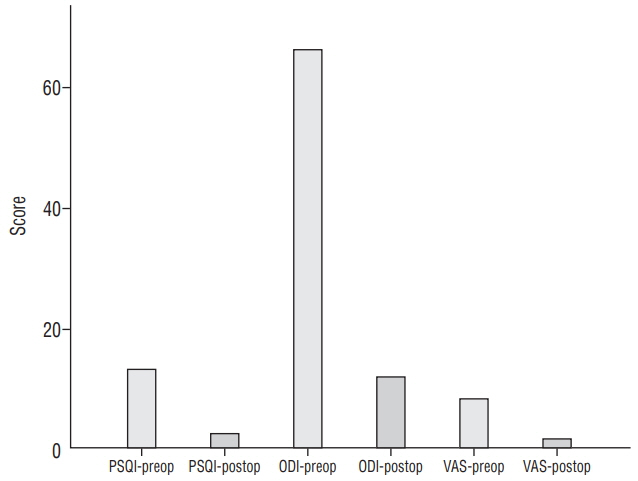J Korean Neurosurg Soc.
2018 Sep;61(5):600-607. 10.3340/jkns.2017.0248.
An Evaluation of the Quality of Sleep Before and After Surgical Treatment of Patients with Cervical Disc Herniation
- Affiliations
-
- 1Department of Neurosurgery, Kirikkale University, Faculty of Medicine, Kirikkale, Turkey. mustafaogden38@gmail.com
- 2Department of Neurosurgery, Yuksek Ihtisas Hospital, Kirikkale, Turkey.
- 3Department of Neurosurgery, Hitit University, Faculty of Medicine, Çorum, Turkey.
- KMID: 2420068
- DOI: http://doi.org/10.3340/jkns.2017.0248
Abstract
OBJECTIVE
It has been reported in recent studies that 50-80% of patients with cervical disc hernia have concomitant sleep disorders. The aim of this study was to evaluate the quality of sleep before and after surgical treatment in patients with cervical disc hernia and to assess the effects on treatment.
METHODS
The study included 32 patients performed discectomy and fusion with an intervertebral cage through the right anterior cervical approach. Oswestry Disability Index (ODI), Visual Analog Scale (VAS) and Pittsburgh Sleep Quality Index (PSQI) were applied to all patients preoperatively and at one month postoperatively.
RESULTS
The postoperative PSQI total points and all the PSQI subscale points, the ODI and VAS scores were significantly reduced compared to the preoperative values. A positive correlation was determined between the preoperative ODI points and the PSQI total points and sleep duration, sleep latency and daytime functional loss subscale points. A positive correlation was also found between preoperative ODI points and VAS points. A positive correlation was determined between the preoperative VAS points and and the PSQI total points and sleep duration, and sleep latency subscale points. A negative correlation was determined between the postoperative ODI and the daytime functional loss subscale points.
CONCLUSION
The results of the study showed that in patients with cervical disc hernia, sleep quality and daytime functionality were negatively affected by severity of pain that limited daily activities. Bringing the pain under control with surgical treatment was observed to increase sleep quality. It can be concluded that when planning treatment for these patients, it should be taken into consideration that there could be a sleep disorder in addition to the complaints and symptoms such as pain, hypoestesia and loss of strength.
Keyword
Figure
Reference
-
References
1. Buysse DJ, Reynolds CF 3rd, Monk TH, Berman SR, Kupfer DJ. The pittsburgh sleep quality index: a new instrument for psychiatric practice and research. Psychiatry Res. 28:193–213. 1989.
Article2. Call-Schmidt TA, Richardson SJ. Prevalence of sleep disturbance and its relationship to pain in adults with chronic pain. Pain Manag Nurs. 4:124–133. 2003.
Article3. Fairbank JC, Couper J, Davies JB, O’Brien JP. The Oswestry low back pain disability questionnaire. Physiotherapy. 66:271–273. 1980.4. Farrar JT, Young JP Jr, LaMoreaux L, Werth JL, Poole RM. Clinical importance of changes in chronic pain intensity measured on an 11-point numerical pain rating scale. Pain. 94:149–158. 2001.
Article5. Fritz JM, Irrgang JJ. A comparison of a modified oswestry low back pain disability questionnaire and the Quebec back pain disability scale. Phys Ther. 81:776–788. 2001.
Article6. Hoy DG, Protani M, De R, Buchbinder R. The epidemiology of neck pain. Best Pract Res Clin Rheumatol. 24:783–792. 2010.
Article7. Marty M, Rozenberg S, Duplan B, Thomas P, Duquesnoy B, Allaert F, Section Rachis de la Société Française de Rhumatologie. Quality of sleep in patients with chronic low back pain: a case-control study. Eur Spine J. 17:839–844. 2008.
Article8. Ozdemir PG, Boysan M, Selvi Y, Yildirim A, Yilmaz E. Psychometric properties of the Turkish version of the sleep hygiene index in clinical and non-clinical samples. Compr Psychiatry. 59:135–140. 2015.
Article9. Parker SL, Godil SS, Shau DN, Mendenhall SK, McGirt MJ. Assessment of the minimum clinically important difference in pain, disability, and quality of life after anterior cervical discectomy and fusion: clinical article. J Neurosurg Spine. 18:154–160. 2013.
Article10. Samancioglu A, Akinci E, Osun A, Ganiusmen O, Ozkan U, Temiz C. Actigraphic analysis of patients with cervical disc herniation. Turk Neurosurg. 27:104–113. 2017.11. Smith MT, Haythornthwaite JA. How do sleep disturbance and chronic pain inter-relate? insights from the longitudinal and cognitive-behavioral clinical trials literature. Sleep Med Rev. 8:119–132. 2004.
Article
- Full Text Links
- Actions
-
Cited
- CITED
-
- Close
- Share
- Similar articles
-
- Surgical Treatment of Cervical Myelopathy Due to Soft Disc Herniation
- Brown Sequard Syndrome Resulting from Cervical Disc Herniation Treated by Anterior Foraminotomy
- The Actual Level of Symptomatic Soft Disc Herniation in Patients with Cervical Disc Herniation
- Evaluation of the Source and Quality of Information Regarding Cervical Disc Herniation on Websites
- Spontaneous Regression of Cervical Disc Herniation: A Case Report


